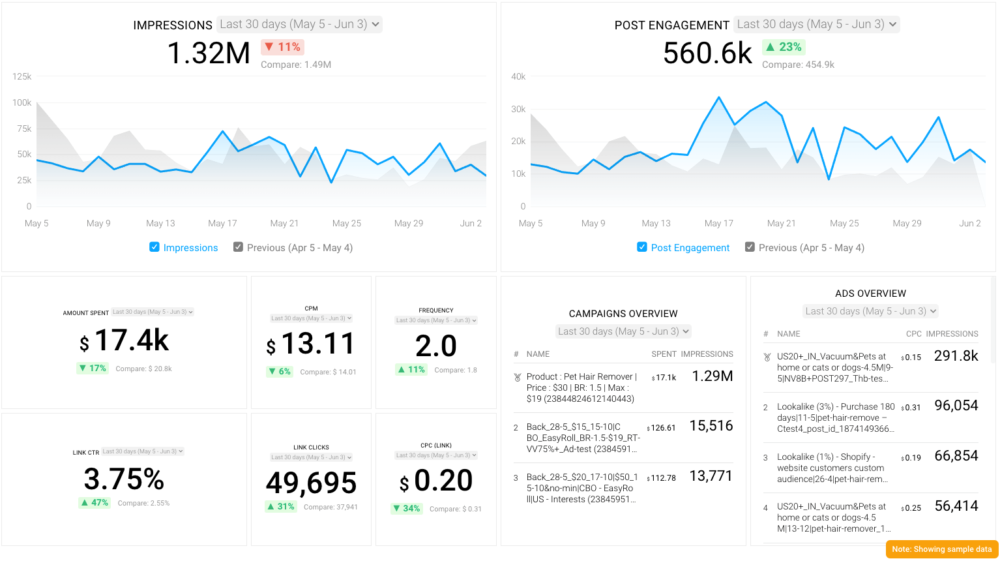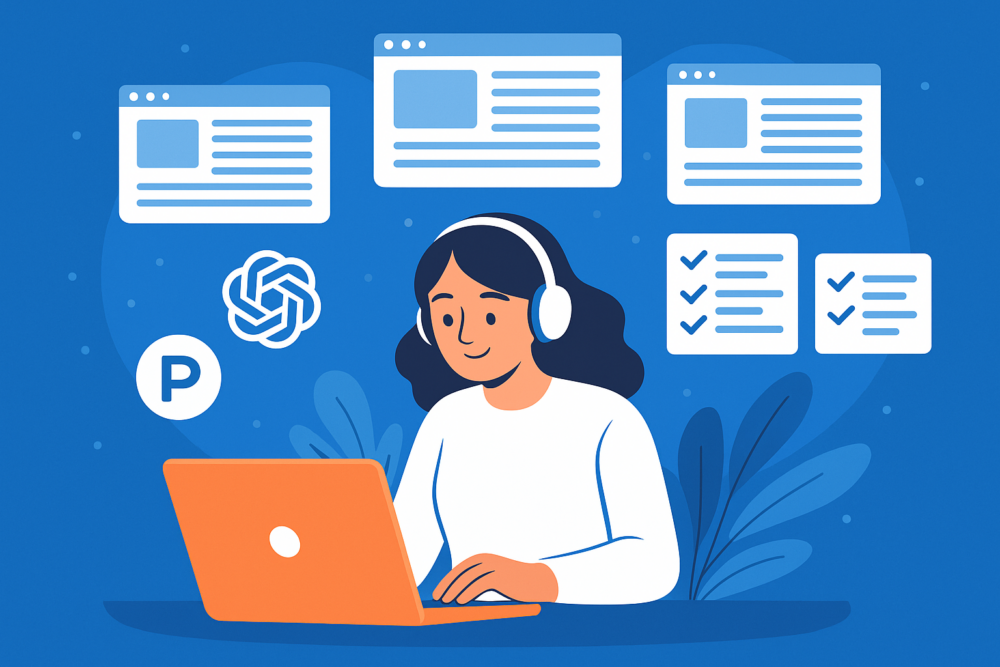Table of contents
Facebook campaign costs, conversion costs, acquisition costs: they all start with a click on your ad.
Ad clicks can drive costs either up or down, depending on the level of targeting sophistication, the ad creative, and how users engage with your ad.
The bottom line: clicks are a signal. And marketers, particularly those focused on paid advertising, live by those signals to inform their strategies and deliver the best possible results at lower costs.
It’s no wonder that they obsess over the click-through rate (CTR) of their Facebook ads. With the costs of Facebook advertising increasing, it’s more important than ever to ensure your ads are driving an optimal number of clicks.
In this article, we’re sharing everything you need to know about Facebook ad click-through rate: what it is, what numbers to use as benchmarks, and how to improve your CTR and generate better results.
Navigate to the section you’re most interested in:
- Facebook Click Through Rate Definition
- How to Calculate Click-Through Rate for Facebook Ads
- How to Find Your CTR on Facebook
- What is Considered a Good CTR for Facebook Ads?
- 6 Ways to Increase CTR for Facebook Ads
Facebook Click-Through Rate Definition
CTR (click-through rate) measures how many times users clicked on your ad after it’s been displayed to them, expressed in percentages (clicks compared to impressions).
It’s a commonly used Facebook Ads metric because it helps marketers determine how well the ads are performing in terms of driving users to their landing page or other desired destination.
By tracking your ad CTR, you can determine:
- If you’ve targeted your audience correctly
- If your ad copy is compelling
- If your ad visual is engaging
The more relevant your ad is for your target audience, the better your CTR will be.
Related: What Is a Good Audience Size For Facebook Ads?
How to Calculate Click-Through Rate for Facebook Ads
Facebook calculates your CTR by dividing an ad’s total number of clicks by the total number of impressions it has. The result is then multiplied by 100 and expressed as a percentage.
For example, if 1,000 people saw your ad, and 100 people clicked on it, Facebook first divides 100 (number of clicks) by 1,000 (number of impressions). The result of that data calculation is 0.1, which is then multiplied by 100 to get your CTR percentage: 10%.
How to Find Your CTR on Facebook
Follow these steps to check the CTR for each of your Facebook ads:
1. Log in to Facebook Ads Manager in the left sidebar on your Facebook homepage.

2. Click on the Ads tab.

3. Make sure you’ve selected the time frame you want to view.

4. Select the Performance and Clicks option under the Columns tab.
In the default view, Facebook shows how many unique clicks an ad received. However, to be able to look at the click-through rate, and not just the number of clicks, you need to select performance and clicks under the Columns tab.

Another way to find your CTR and customize columns is to scroll all the way to the right and click on the small, blue plus sign. Click on Customize columns.

Find CTR under Performance and tick the box next to it.

5. Scroll right until you see the column for “CTR (All).”

What is Considered a Good CTR for Facebook Ads?
According to Databox’s own Benchmark data, the median CTR for Facebook Ads across all industries is 1.54.
This benchmark was calculated from anonymized data from close to 1250 companies. Do you want to benchmark your Facebook Ads performance, including Reach frequency, clicks, CTR, CPM, CPC, and more, against other companies like yours? Join the Benchmark Group for free.

*Important note: Databox Benchmark Groups show median values. The median is calculated by taking the “middle” value, the value for which half of the observations are larger and half are smaller. The average is calculated by adding up all of the individual values and dividing this total by the number of observations. While both are measures of central tendency, when there is a possibility of extreme values, the median is generally the better measure to use.
Given that the numbers are different across industries, there’s no saying that a specific CTR is good for any Facebook ads campaign. You can use these benchmarks as reference points to compare your Facebook ads campaign performance, but in general, whether your CTR is good depends on your campaign goals, ROI, and other metrics.
At Databox, we conducted our own research and surveyed 62 companies that are actively advertising on Facebook. About half of the companies that participated in the survey are agencies.

Most of the survey respondents are experienced when it comes to Facebook ads (with over five years of advertising on the platform).

About a quarter of our survey respondents have Facebook CTR between 0.51 and 1, which is close to our Benchmark data.
This is the largest group in our segmentation. As expected, the number of businesses having higher CTR values decreases as the value grows.

Benchmark Your Performance Against Hundreds of Companies Just Like Yours
Viewing benchmark data can be enlightening, but seeing where your company’s efforts rank against those benchmarks can be game-changing.
Browse Databox’s open Benchmark Groups and join ones relevant to your business to get free and instant performance benchmarks.
6 Ways to Increase CTR for Facebook Ads
We asked our surveyed experts to share their best tips on improving the Facebook ads CTR. Here’s what they suggest to do to make the most out of your advertising budget and ensure your future campaigns are successful.
- Narrow Your Targeting
- Run Retargeting Campaigns
- Use Engaging Visuals
- Improve Your Ad Copy
- Leverage Social Proof
- Split Test Everything
1. Narrow Your Targeting
When your audience is too broad, your message can’t be strong enough because you’re trying to resonate with too many people. However, if you narrow your target audience, you can craft more compelling messages and generate more clicks.
“When your paid media strategist narrows your targeting, you’re speaking to a smaller customer base, and you now have specificity and empathy on your side,” says Evolve Digital Labs’ Ian Revling.
“Any time your creative becomes more specific to an audience, they’re more likely to click your ad, engage with comments, share with friends and family, or click through to a conversion,” Revling adds.
Dominick Sorrentino from Brafton also reminds us that “Narrowing your audience isn’t just about CTR. It’s also about conversion rates. Across all industries, Facebook has a conversion rate of 9.21%, meaning for every 100 clicks on an ad, roughly 9 people will convert. Relative to other paid channels such as display and search, that’s actually very strong. Take advantage of this potential by zeroing in on an audience that’s not only likely to click on your ad, but is also most likely to fill out the form on the other side of it.”
Isabella Gordan at Sleepy’s Express shares how her team used narrowed targeting to increase their CTR from 0.84% to 1.01% in 80 days. “We did this by excluding people who had already converted and only targeted those who hadn’t visited our website before. This helped to improve our click-through rate because we weren’t wasting impressions on people who were already familiar with our product.”
“We also made sure to target people in our target demographic and who lived in our target market. The change in our click-through rate was quick and apparent, and it taught us that a small fraction generally makes up the most results.”
PRO TIP: What’s the overall engagement of your ad campaigns?
Want to make sure your Meta ads are performing and trending in the right direction across platforms? There are several types of metrics you should track, from costs to campaign engagement to ad-level engagement, and so on.
Here are a few we’d recommend focusing on.
- Cost per click (CPC): How much are you paying for each click from your ad campaign? CPC is one of the most commonly tracked metrics, and for good reason, as if this is high, it’s more likely your overall return on investment will be lower.
- Cost per thousand impressions (CPM): If your ad impressions are low, it’s a good bet everything else (CPC, overall costs, etc.) will be higher. Also, if your impressions are low, your targeting could be too narrow. Either way, it’s important to track and make adjustments when needed.
- Ad frequency: How often are people seeing your ads in their news feed? Again, this could signal larger issues with targeting, competition, ad quality, and more. So keep a close eye on it.
- Impressions: A high number of impressions indicates that your ad is well optimized for the platform and your audience.
- Amount spent: Tracking the estimated amount of money you’ve spent on your campaigns, ad set or individual ad will show you if you staying within your budget and which campaigns are the most cost-effective.
Tracking these metrics in Facebook Ads Manager can be overwhelming since the tool is not easy to navigate and the visualizations are quite limiting. It’s also a bit time-consuming to combine all the metrics you need in one view.
We’ve made this easier by building a plug-and-play Facebook Ads dashboard that takes your data and automatically visualizes the right metrics to give you an in-depth analysis of your ad performance.
With this Facebook Ads dashboard, you can quickly discover your most popular ads and see which campaigns have the highest ROI, including details such as:
- What are your highest performance Facebook Ad campaigns? (impressions by campaign)
- How many clicks do your ads receive? (click-through rate)
- Are your ad campaigns under or over budget? (cost per thousand impressions)
- What are your most cost-efficient ad campaigns? (amount spent by campaign)
- How often are people seeing your ads in their news feed? (ad frequency)
And more…
You can easily set it up in just a few clicks – no coding required.
To set up the dashboard, follow these 3 simple steps:
Step 1: Get the template
Step 2: Connect your Facebook Ads account with Databox.
Step 3: Watch your dashboard populate in seconds.
2. Run Retargeting Campaigns
Retargeting campaigns are a good way to deal with the iOS privacy changes and increase your CTR by reaching people who have already shown interest in your product or service.
“Ever since the iOS change, a lot of the audiences Facebook leverages 3rd party data for stopped working as well as they once did (i.e. lookalike audiences), so we pivoted to leveraging their 1st party data,” says Andrew Maff of BlueTuskr.
“We still target Purchases, but we’ve also developed some campaigns around targeting Traffic and then focusing on retargeting that audience. This allows us to find a relevant audience and then let our retargeting campaigns do the work. Because of this approach, we’re still seeing ROIs almost as good as we were prior to the iOS changes and CTRs staying much higher than the industry averages.”
Rebecca Long of VisualFizz agrees that retargeting is an effective way to increase your CTR.
“To garner a better CTR, use retargeting ads continually. Users who aren’t familiar with your brand likely aren’t going to click on the first ad they see. Once they have been shown ads a few times and are then retargeted with deeper funnel messaging the chances of users clicking on your ad increases tremendously.”
Bogdan Zlatkov of RollWorks confirms that “the best way to improve your conversions overall is by staying top-of-mind after someone visits your site.”
“According to the Interactive Advertising Bureau, 91% of marketers who have used retargeting have found it to perform equally or better than search, email, or other display ads. When Oracle Dyn used retargeting ads they got a 4x return on investment and a 28% increase in marketing qualified leads,” Zlatkov says.
Related: 11 Facebook Retargeting Tips For Converting Warm Leads
3. Use Engaging Visuals
Engaging visuals are more likely to stop people while they’re scrolling through their Facebook feed and make them take another look at your ad. As we’re all being bombarded with ads anywhere we turn, it’s critical that your ad stand out from the rest to gain attention, and consequently, clicks.
“One effective way to improve the click-through rate on your Facebook ads is to incorporate more engaging visuals such as videos, GIFs, or infographics,” says Jackie Tihanyi of Fisher Unitech. “People are used to seeing the same static images when scrolling through Facebook, so spicing up the newsfeed with some dynamic content increases the probability of a click,” Tihanyi explains.
KDG’s Keri Lindenmuth agrees: “The key to a successful ad campaign on Facebook is to make sure your content stands out. This is why videos and images work so well. Users are attracted to strong visuals, especially when they involve other people.”
By adding a compelling video to their ad, Jumpstart Go’s Rene Cabrera increased his CTR by 10%. But not everyone recommends video.
“Surprisingly, we’ve seen that images have better click-through rates than videos for Facebook ad campaigns,” says Jeneeit Jeyakanthan, CEO of Vilampara Media. Jeyakanthan does note, however, that videos are better for brand-building and engagement.
4. Improve Your Ad Copy
Short, relatable copy is usually the best way to gain your audience’s attention and make them want to click on your ad. A compelling message in your ad (including the CTA) can make a huge difference in your CTR and here’s what experts advise you try.
Add personal attributes to ads. John Morgan of The Penny Hoarder says his current campaign that uses the headline “If you live in Pennsylvania” is getting a CTR of 13.7%! (Note that this is closely related to narrow targeting!)
Write a compelling title. “From our experience, the number-one factor in improving your Facebook CTR is through effective titles,” says Angelo Frisina of Sunlight Media. “Having a correctly optimized ad title can increase your CTR by over 50%.” Matthew Martinez of Diamond Real Estate Group agrees:
“The headline is one of the first contact points we have with our audience, so to increase our CTR, we experimented with different headlines. We use personalized language including words like “you” and “your” and specific demographic information. We keep them between 60 to 100 characters, use a CTA in the headline and have numbered titles. We’ve noticed that a number increases CTRs by up to 30+%.
Ask a question in your copy. “Ask a question in your ad, and be sure to follow up quickly and professionally on your responses,” says Mike Schiemer of Bootstrap Business. “The higher engagement rates with the ads will enhance the legitimacy of the ad. You’ll get more shares and link clicks.”
Answer a question. “Answer a user’s initial question in your ad, but also guide them to click through to your landing page,” says Rachel Bills of Intuitive Digital. Optimize your landing page so that when a user lands, it’s easy for them to find what they’re looking for.”
Keep it short. “Our average CTR has been 1.52% over the years,” reveals Charles Cridland of YourParkingSpace. “This is because we keep our ads short and sweet. People scrolling through their newsfeeds are quickly overwhelmed with information, and they’re more likely to engage with an ad that is direct and to the point. We limit our posts between 120 and 140 characters, which gives us the highest rate of engagement.”
“Providing less information in an otherwise engaging ad makes the audience eager to click on your link and answer their questions. The idea is to deliver only the important information on the post and leave the rest of the story to be told on your landing page,” explains Cridland.
Related: How to Write Facebook Ads That Convert: 21 Expert Tips & Examples
5. Leverage Social Proof
Social proof is a powerful tool to motivate people to buy: CXL’s study found that there’s a strong connection between the number of stars people leave in reviews and the number of orders that a specific product has. You can leverage this fact to craft more compelling Facebook ads and increase your CTR.
You can also build social proof by getting more likes, comments, and shares on your ads.
“A new ad with a winning image/video and copy from testing usually only has few comments/likes/shares to start,” says Kalina Fridrich of Social Fulcrum. “This usually means CTRs are rarely above 0.5% for new Facebook ads.”
“To help boost CTRs, we build social proof by accumulating post engagement. To do this, we use Page Post IDs to link the same ad across various ad sets to ensure the post engagement is cumulative.”
“We also show new ads with low engagement to audiences with the most loyal customers (high LTV, long relationship with the brand) to collect positive comments from current customers.”
“We’ve seen the same ads with 0.5% CTR jump to 0.7%-1% CTR as a result of a rigorous collection of post engagement. We believe ad engagement provides social proof and builds virality,” Fridrich says.
6. Split Test Everything
Testing a variety of ad elements is the only way to learn what really works, which is why many marketers recommend split testing your ads.
Growth Hackers’ Jonathan Aufray confirms that split testing is highly relevant. “When I say A/B testing, I mean you need to test everything in your ad: copy, targeting, objective, ad types, etc. In fact, I recommend doing even more than A/B testing; I’d call it A/B/C testing or A to Z testing.”
“What I recommend is creating at least two identical Facebook ads where you just test one thing at a time (for instance, the copy). Then, once you find the right copy, you create several ads with that copy where you test different targets. Once you find the right target, you can test the ad format, and so on,” Aufray says.
Andrew Clark of David.Market shares his agency experience: “My agency tested a variety of headlines and primary text variations to identify the best type of messaging for encouraging clicks,” says Clark.
“Facebook Ads, which allow up to five variations of each, makes this testing a breeze and a go-to for all of our client campaigns. While it may seem time-consuming initially to draft multiple sets of text, it’s important to try out different angles and experiment with length.”
R.J. Weiss of The Ways to Wealth gives similar advice: “For my ads, I rotate weekly through testing audience, image, headline, and text. Then, repeat.”
“The goal each week is to test at least four new ads in each campaign I have running. Often it can be weeks or months until I’m able to improve upon a control. But once I do, the reward means a higher CTR and lower Facebook Ads CPM,” Weiss adds.
Stay on Top of Your Facebook Ads Campaign Performance
You can achieve a good CTR by carefully creating an ad that will resonate with your audience, grabbing their attention with an engaging visual, and conveying your message in a powerful way. By applying the tips we shared in the article, you can also improve the performance of your Facebook ads and keep working on optimizing your future campaigns.
However, to get the most out of each campaign, it’s not enough to track CTR only: there are more Facebook ads metrics you need to monitor to make sure your budget isn’t wasted. And if you’re running multiple campaigns at the same time and want to track data from different sources, things can get complicated easily.
Not with Databox.
If you connect your Databox dashboard with Facebook Ads Manager, you can easily track your most important data in one place, customize the dashboard to fit your needs, get automated reports that are easily shared with your team, and monitor progress toward the goals you’ve set for each campaign. With Databox Facebook ad campaign dashboards, you won’t miss an opportunity to fix a low-performing ad or boost a top performer and generate more revenue ever again.
But don’t trust our words—see for yourself. Sign up for a free trial today.















